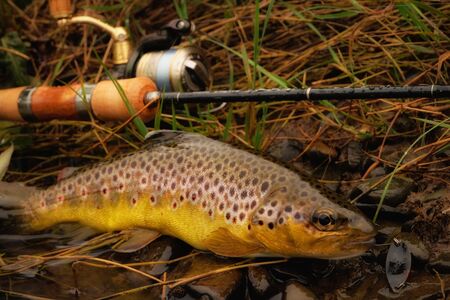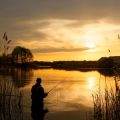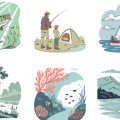1. Understanding the Benefits of a Modular Tackle System
If youre an angler who enjoys chasing different species—from bass and crappie to trout and catfish—you know that each type of fish often requires different gear. That’s where a modular tackle system comes in handy. Instead of hauling one massive tackle box packed with everything under the sun, a modular setup lets you stay organized, flexible, and more efficient on the water.
What Is a Modular Tackle System?
A modular tackle system is a customizable setup where your gear is divided into separate compartments or containers based on fishing style, species, or location. Think of it like having a toolbox with removable trays, each dedicated to a specific job. This system allows you to grab exactly what you need for the day without overpacking.
Why It’s Perfect for Multi-Species Fishing
Fishing for multiple species means dealing with different bait types, hook sizes, line strengths, and lures. A modular tackle system helps keep everything in its place so you can quickly switch tactics when the bite changes or when youre targeting another species.
Top Benefits of a Modular Tackle System
| Benefit | Description |
|---|---|
| Efficiency | No more digging through tangled lures or mixed-up hooks—grab what you need fast and get back to casting. |
| Organization | Each module can be labeled and sorted by species, technique, or season. |
| Adaptability | Easily swap out modules depending on your target fish or fishing location. |
| Portability | Lighter loads mean easier transport from your vehicle to the boat or shoreline. |
An Example: Bass vs. Trout Setup
If you’re going after bass one weekend and trout the next, just swap out your “bass” module with your “trout” module. Here’s how that might look:
| Tackle Module | Bass Fishing | Trout Fishing |
|---|---|---|
| Lures | Craws, spinnerbaits, topwater frogs | Spoons, inline spinners, small crankbaits |
| Hooks | Wide gap worm hooks | Trebles and single egg hooks |
| Main Line Type | Braided or fluorocarbon (12–20 lb) | Monofilament or fluorocarbon (2–6 lb) |
A modular approach keeps all this gear separated so you’re not fumbling through irrelevant tackle when time matters most.
2. Choosing the Right Tackle Storage Solutions
When youre gearing up for multi-species fishing adventures, having the right tackle storage system can make or break your day on the water. A modular setup lets you quickly switch gear based on the species youre targeting or the type of water youre fishing. Lets break down the different storage options that work best for a modular system and help keep your gear organized, accessible, and ready to go.
Hard Tackle Boxes
These are the traditional go-to for many anglers. They offer solid protection and often come with adjustable compartments for organizing lures, hooks, weights, and tools. Some even feature pull-out trays or drawers for easy access. Hard tackle boxes are ideal for boat fishing or when you have a designated fishing spot where weight isn’t an issue.
Pros:
- Durable and protective
- Great for storing fragile or sharp items
- Often waterproof or water-resistant
Cons:
- Bulky and heavy
- Less flexible than soft bags
Soft Tackle Bags
Soft tackle bags are popular among shore anglers and those who prefer mobility. These bags usually come with multiple zippered compartments and can hold removable plastic tackle trays. They’re lightweight, easy to carry, and often come with shoulder straps or backpack-style designs.
Pros:
- Lighter and more portable
- Modular-friendly with removable trays
- Pockets for tools, leader lines, snacks, etc.
Cons:
- Less protective than hard boxes
- Can absorb moisture if not waterproof
Tackle Trays & Utility Boxes
Tackle trays (like Plano 3700 series) are the backbone of a modular system. You can organize them by species (bass, trout, catfish), technique (topwater, jigging, trolling), or conditions (clear water vs murky). These fit into both hard boxes and soft bags, giving you maximum flexibility.
| Tray Size | Use Case | Fits In |
|---|---|---|
| 3600 Series | Compact setups, finesse rigs | Small bags or backpacks |
| 3700 Series | Main tackle tray for most species | Larger soft bags/hard boxes |
| Large Deep Trays | Bigger lures, bulk storage | Boat compartments or large tackle stations |
Buckets & Specialty Containers
If youre fishing from shorelines, docks, or piers—especially for species like catfish or carp—you might benefit from a five-gallon bucket with an organizer insert or a bait cooler. These containers can double as seats and carry live bait along with other essentials.
Popular Add-ons:
- Lid organizers with compartments for hooks and sinkers
- Aerated bait containers for live minnows or shrimp
- Cushioned seat lids for comfort during long sessions
Selecting Based on Your Fishing Environment
Your choice of storage should match how and where you fish. Here’s a quick guide:
| Fishing Style | Recommended Storage Solution |
|---|---|
| Boat Fishing | Hard tackle box + labeled utility trays (3700 size) |
| Kayak Fishing | Slim soft bag + waterproof trays + space-saving layout |
| Shore/Bank Fishing | Backpack-style soft bag + buckets with inserts + portable rod holders |
| Pier Fishing/Night Sessions | Bait bucket + LED-lit soft bag + compact trays with glow-in-the-dark lures/hooks sectioned out by species/technique |
A well-thought-out tackle storage solution tailored to your fishing style helps reduce clutter and makes it easier to swap gear quickly. Whether youre chasing largemouth bass in freshwater lakes or redfish in coastal waters, having the right storage setup ensures you spend less time digging through your gear—and more time catching fish.
![]()
3. Organizing by Species and Technique
When youre targeting multiple fish species, keeping your tackle system organized by both species and technique is a game-changer. This approach helps you stay efficient on the water and makes switching setups quick and easy. Instead of rummaging through a single box of mixed gear, you’ll know exactly where everything is based on what youre fishing for and how youre fishing for it.
Why Organize by Species?
Different fish have different preferences. Largemouth bass love soft plastics and crankbaits, while trout might go for small spinners or flies. Having dedicated storage per species keeps your gear focused and prevents unnecessary clutter. It also helps ensure you don’t forget key lures or terminal tackle when switching targets.
Why Include Techniques in Your Organization?
Not only does each fish species favor certain types of bait, but the way you present that bait—whether its finesse, topwater, jigging, or trolling—matters too. By organizing gear around techniques, you can quickly adapt to changing conditions or switch up strategies without unpacking your entire setup.
Sample Modular Tackle Layout
Here’s a sample table showing how you might organize your gear using modular tackle boxes labeled by both species and technique:
| Box Label | Target Species | Main Techniques | Included Gear |
|---|---|---|---|
| Bass – Topwater | Largemouth Bass | Topwater Casting | Frogs, Poppers, Buzzbaits, Leader Line |
| Trout – Ultralight | Rainbow/Brown Trout | Spinning, Drift Fishing | Inline Spinners, Small Spoons, Split Shot Weights |
| Panfish – Float Rig | Bluegill, Crappie | Bobber Fishing | Balsa Floats, Small Hooks, Wax Worms (artificial), Jig Heads |
| Catfish – Bottom Rig | Channel/Blue Catfish | Bottom Fishing with Bait | Circle Hooks, Sinkers, Leader Rigs, Bait Clips |
| Pike – Power Setup | Northern Pike | Casting Large Lures | Spoons, Spinnerbaits, Wire Leaders, Swivels |
Pro Tip: Color Code or Label Everything
A simple way to speed things up even more is to color-code your boxes or use bold labels. Use waterproof stickers or permanent markers to label each box clearly with the target species and method. Some anglers even use different colored utility boxes—for example, red for bass setups and blue for trout—to make identification lightning fast.
The Benefit on the Water
This kind of organization lets you grab just the right box before a trip depending on what youre targeting that day. If youre chasing bass in the morning and switching to panfish in the afternoon, just swap out the relevant boxes in your backpack or boat compartment without repacking everything.
4. Must-Have Tackle Components for Versatility
When youre targeting multiple species on a single trip, your tackle system needs to be ready for anything. That means building out your modules with gear that covers a wide range of scenarios—from finesse fishing for crappie to battling hard-fighting bass or even saltwater intruders like redfish. Below is a breakdown of essential tackle components you should include in each module to ensure youre ready no matter what bites.
Terminal Tackle
This is the foundation of every successful rig. Stock up on a variety of hooks, weights, and swivels so you can adapt quickly.
| Component | Recommended Types | Target Species |
|---|---|---|
| Hooks | Circle, EWG (Extra Wide Gap), Octopus, Aberdeen | Bass, Catfish, Panfish, Walleye |
| Weights | Split Shot, Bullet Weights, Egg Sinkers | Trout, Bass, Catfish |
| Swivels & Snaps | Barrel Swivels, Snap Swivels | Pike, Saltwater Species |
Lures & Baits
A versatile lure selection is key for covering different depths and water conditions. Focus on lures that are proven across species.
| Lure Type | Description | Best For |
|---|---|---|
| Soft Plastics | Grubs, Worms, Swimbaits in various sizes/colors | Bass, Crappie, Walleye |
| Crankbaits | Divers and lipless models for different depths | Bass, Pike, Trout |
| Spoons & Spinners | Flashy metals that mimic baitfish action | Trout, Salmon, Panfish |
| Topwater Lures | Poppers and frogs for surface strikes | Bass, Pike |
Tools & Accessories
You’ll need more than just hooks and lures to stay efficient out there. Make sure each module includes tools that help you fish smarter and safer.
- Pliers: For hook removal and crimping split shot.
- Line Clippers: Quick and clean cuts on all line types.
- Knot-Tying Tool: Especially handy in cold weather or low light.
- Tackle Labels: Helps keep your modular boxes organized by species or technique.
- Small First Aid Kit: Minor cuts and scrapes happen—be prepared.
- Tape Measure or Fish Ruler: Know what’s legal to keep in your state.
Tackle Storage Tips for Multi-Species Fishing
The goal is to stay mobile and organized. Use clear utility boxes or color-coded tackle trays to separate gear by category or species. Label each box clearly—for example: “Panfish Essentials,” “Bass Reaction Baits,” or “Saltwater Ready.” This way you can grab exactly what you need without rummaging through your entire tackle bag.
Pro Tip:
If you fish both fresh and saltwater environments frequently, consider having dedicated modules for each. Saltwater gear tends to corrode faster—keeping it separated helps preserve your freshwater setups longer.
The Takeaway:
Your modular tackle system should be flexible but not overloaded. Stick with proven gear that works across multiple species and situations. Keep it light enough to carry but complete enough to cover surprises. The right components in the right setup will make your multi-species fishing adventures smoother—and a lot more fun!
5. Tips for Packing and Traveling with Your Modular System
When youre heading out on a fishing trip—whether its a quick roadside stop, a full day on the boat, or paddling out in your kayak—how you pack your modular tackle system can make or break your experience. A well-organized setup keeps your gear protected, easy to access, and ready to adapt to whatever the water throws at you. Here are some practical tips to keep your tackle system travel-ready and efficient.
Choose the Right Tackle Storage for Your Trip Type
Different fishing platforms call for different packing strategies. Use the table below to guide how you organize your tackle modules based on where youre going:
| Fishing Platform | Recommended Storage Style | Why It Works |
|---|---|---|
| Kayak | Waterproof soft tackle bags with labeled pouches | Compact, lightweight, fits tight spaces; easy to strap down |
| Boat | Hard tackle boxes with removable trays or bins | Sturdy and organized; lots of room for multiple species setups |
| Roadside / Bank Fishing | Backpack-style tackle systems or sling bags | Portable and hands-free; great when walking long distances |
Pre-Pack by Target Species
Create individual modules or trays for specific species like bass, trout, panfish, or catfish. This way, youre not digging through saltwater jigs when all you need is a finesse worm for largemouths. Label each box clearly and only bring the ones youll need for that day’s target.
Use Clear Labels and Color Codes
A color-coded system makes it super easy to grab what you need without opening every container. For example:
- Green labels = freshwater bass lures
- Blue labels = saltwater rigs
- Red labels = terminal tackle (hooks, weights, swivels)
You can use waterproof stickers or even permanent markers on plastic boxes.
Keep Essentials Accessible
No matter where youre fishing from, always keep core items like pliers, line cutters, leader spools, sunscreen, and your fishing license in an outer pocket or top compartment. That way you won’t have to unpack everything just to tie on a new rig.
Secure Your Gear for Transport
If youre traveling by car, boat, or kayak, secure your tackle system using bungee cords or straps. Make sure nothing can tip over or slide around—especially if water is involved. Dry bags are also a great backup option for valuables like electronics or wallets.
Bonus Tip: Build a Grab-and-Go Checklist
Create a simple checklist that includes your rods, pre-packed tackle modules, safety gear, snacks, and hydration. Laminate it and keep it near your gear area so you never forget an essential item again.
6. Maintaining and Upgrading Your System Over Time
Once you’ve built your modular tackle system, keeping it in top shape is just as important as putting it together. A well-maintained setup means fewer headaches on the water and more time catching fish. Here’s how you can keep your gear fresh and effective year-round.
Stay in Sync with the Seasons
Different species become active at different times of the year, and your tackle system should reflect that. Rotate gear based on seasonal changes to ensure youre always prepared for what’s biting.
| Season | Target Species | Tackle Adjustments |
|---|---|---|
| Spring | Bass, Crappie, Trout | Add soft plastics, smaller crankbaits, inline spinners |
| Summer | Catfish, Largemouth Bass, Saltwater Inshore | Stock up on live bait rigs, topwater lures, saltwater jigs |
| Fall | Pike, Walleye, Salmon | Include jerkbaits, spoons, deep-diving crankbaits |
| Winter | Ice Fishing Species (Perch, Panfish) | Add ice jigs, tip-ups, compact tackle boxes for mobility |
Create a Regular Cleaning Routine
Dirt, saltwater residue, and old bait gunk can wear down your gear fast. Set up a simple monthly or post-trip cleaning routine to protect your investment.
- Tackle Boxes: Empty them out and wipe with a damp cloth. Let dry completely before restocking.
- Lures: Rinse off with freshwater after each trip—especially if fishing saltwater—and check hooks for rust.
- Terminal Tackle: Organize by type and size; discard anything corroded or broken.
Add New Gear Without Starting Over
The beauty of a modular system is that it grows with you. As new technology hits the market—like smart lures, UV-enhanced plastics, or lighter terminal tackle—you can easily integrate them into your existing setup without an overhaul.
Tips for Smart Upgrades:
- Add-on Trays: Expand your box with additional trays or dividers to sort new gear.
- Pouch Storage: Use labeled zip pouches for soft baits or specialty rigs you don’t use often.
- Tackle Tags: Label compartments with whats inside to save time during rigging.
A little ongoing effort keeps your modular tackle system dialed in all year long. Stay organized, stay updated—and you’ll be ready for any fishing adventure that comes your way.


